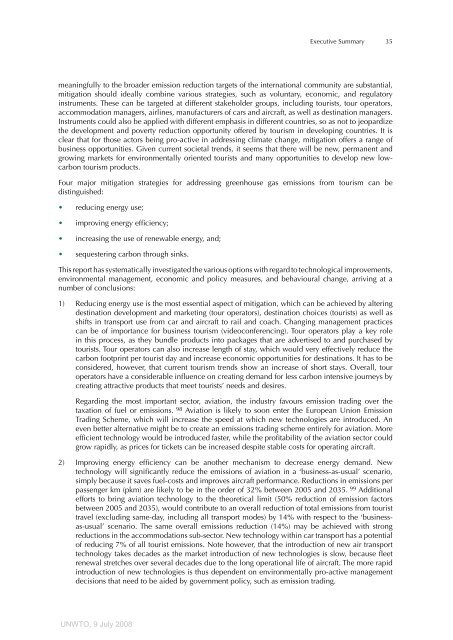Climate Change and Tourism - UNEP - Division of Technology ...
Climate Change and Tourism - UNEP - Division of Technology ...
Climate Change and Tourism - UNEP - Division of Technology ...
You also want an ePaper? Increase the reach of your titles
YUMPU automatically turns print PDFs into web optimized ePapers that Google loves.
UNWTO, 9 July 2008<br />
Executive Summary<br />
meaningfully to the broader emission reduction targets <strong>of</strong> the international community are substantial,<br />
mitigation should ideally combine various strategies, such as voluntary, economic, <strong>and</strong> regulatory<br />
instruments. These can be targeted at different stakeholder groups, including tourists, tour operators,<br />
accommodation managers, airlines, manufacturers <strong>of</strong> cars <strong>and</strong> aircraft, as well as destination managers.<br />
Instruments could also be applied with different emphasis in different countries, so as not to jeopardize<br />
the development <strong>and</strong> poverty reduction opportunity <strong>of</strong>fered by tourism in developing countries. It is<br />
clear that for those actors being pro-active in addressing climate change, mitigation <strong>of</strong>fers a range <strong>of</strong><br />
business opportunities. Given current societal trends, it seems that there will be new, permanent <strong>and</strong><br />
growing markets for environmentally oriented tourists <strong>and</strong> many opportunities to develop new lowcarbon<br />
tourism products.<br />
Four major mitigation strategies for addressing greenhouse gas emissions from tourism can be<br />
distinguished:<br />
•<br />
•<br />
•<br />
•<br />
reducing energy use;<br />
improving energy efficiency;<br />
increasing the use <strong>of</strong> renewable energy, <strong>and</strong>;<br />
sequestering carbon through sinks.<br />
This report has systematically investigated the various options with regard to technological improvements,<br />
environmental management, economic <strong>and</strong> policy measures, <strong>and</strong> behavioural change, arriving at a<br />
number <strong>of</strong> conclusions:<br />
1) Reducing energy use is the most essential aspect <strong>of</strong> mitigation, which can be achieved by altering<br />
destination development <strong>and</strong> marketing (tour operators), destination choices (tourists) as well as<br />
shifts in transport use from car <strong>and</strong> aircraft to rail <strong>and</strong> coach. Changing management practices<br />
can be <strong>of</strong> importance for business tourism (videoconferencing). Tour operators play a key role<br />
in this process, as they bundle products into packages that are advertised to <strong>and</strong> purchased by<br />
tourists. Tour operators can also increase length <strong>of</strong> stay, which would very effectively reduce the<br />
carbon footprint per tourist day <strong>and</strong> increase economic opportunities for destinations. It has to be<br />
considered, however, that current tourism trends show an increase <strong>of</strong> short stays. Overall, tour<br />
operators have a considerable influence on creating dem<strong>and</strong> for less carbon intensive journeys by<br />
creating attractive products that meet tourists’ needs <strong>and</strong> desires.<br />
Regarding the most important sector, aviation, the industry favours emission trading over the<br />
taxation <strong>of</strong> fuel or emissions. 98 Aviation is likely to soon enter the European Union Emission<br />
Trading Scheme, which will increase the speed at which new technologies are introduced. An<br />
even better alternative might be to create an emissions trading scheme entirely for aviation. More<br />
efficient technology would be introduced faster, while the pr<strong>of</strong>itability <strong>of</strong> the aviation sector could<br />
grow rapidly, as prices for tickets can be increased despite stable costs for operating aircraft.<br />
2) Improving energy efficiency can be another mechanism to decrease energy dem<strong>and</strong>. New<br />
technology will significantly reduce the emissions <strong>of</strong> aviation in a ‘business-as-usual’ scenario,<br />
simply because it saves fuel-costs <strong>and</strong> improves aircraft performance. Reductions in emissions per<br />
passenger km (pkm) are likely to be in the order <strong>of</strong> 32% between 2005 <strong>and</strong> 2035. 99 Additional<br />
efforts to bring aviation technology to the theoretical limit (50% reduction <strong>of</strong> emission factors<br />
between 2005 <strong>and</strong> 2035), would contribute to an overall reduction <strong>of</strong> total emissions from tourist<br />
travel (excluding same-day, including all transport modes) by 14% with respect to the ‘businessas-usual’<br />
scenario. The same overall emissions reduction (14%) may be achieved with strong<br />
reductions in the accommodations sub-sector. New technology within car transport has a potential<br />
<strong>of</strong> reducing 7% <strong>of</strong> all tourist emissions. Note however, that the introduction <strong>of</strong> new air transport<br />
technology takes decades as the market introduction <strong>of</strong> new technologies is slow, because fleet<br />
renewal stretches over several decades due to the long operational life <strong>of</strong> aircraft. The more rapid<br />
introduction <strong>of</strong> new technologies is thus dependent on environmentally pro-active management<br />
decisions that need to be aided by government policy, such as emission trading.<br />
35

















